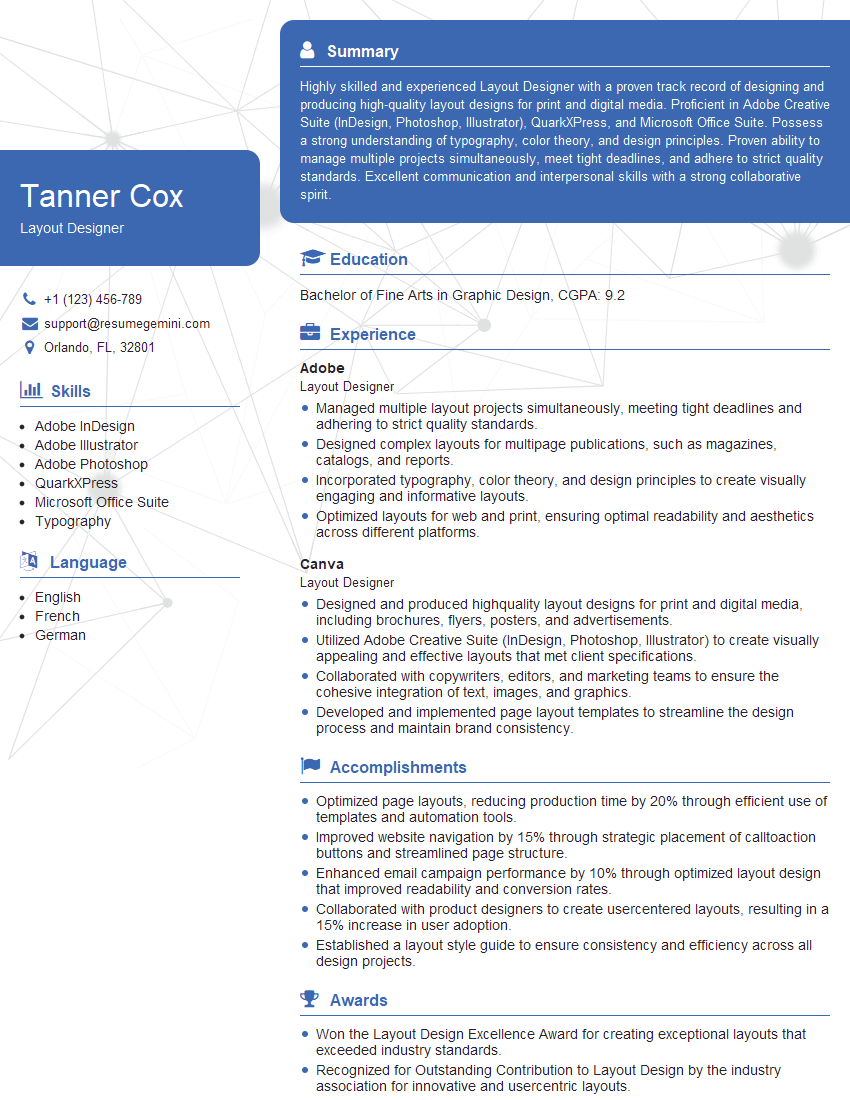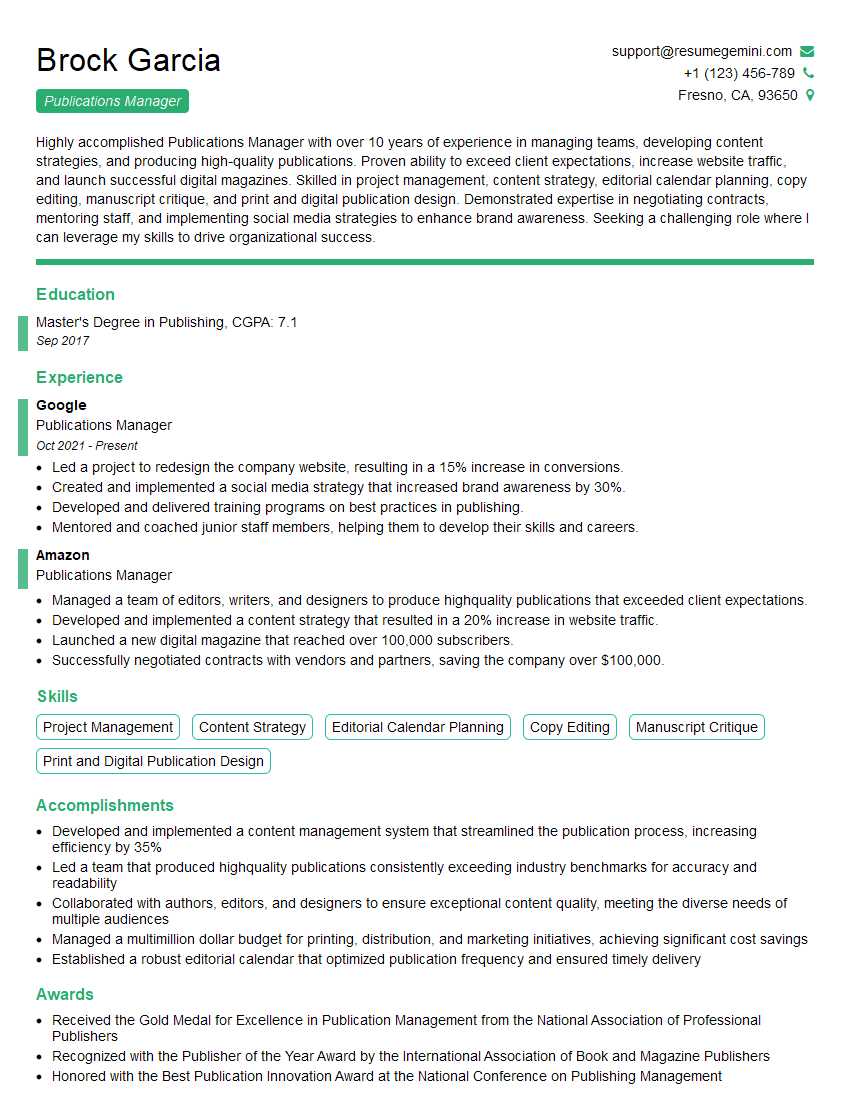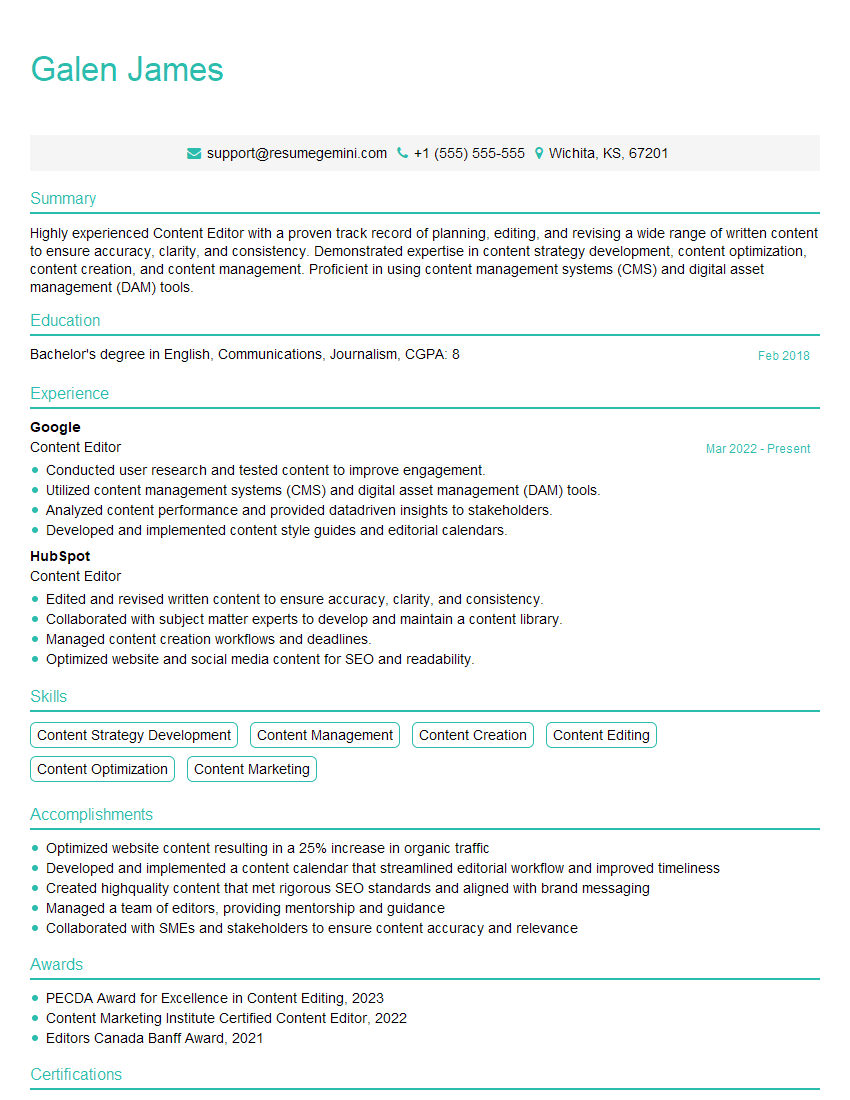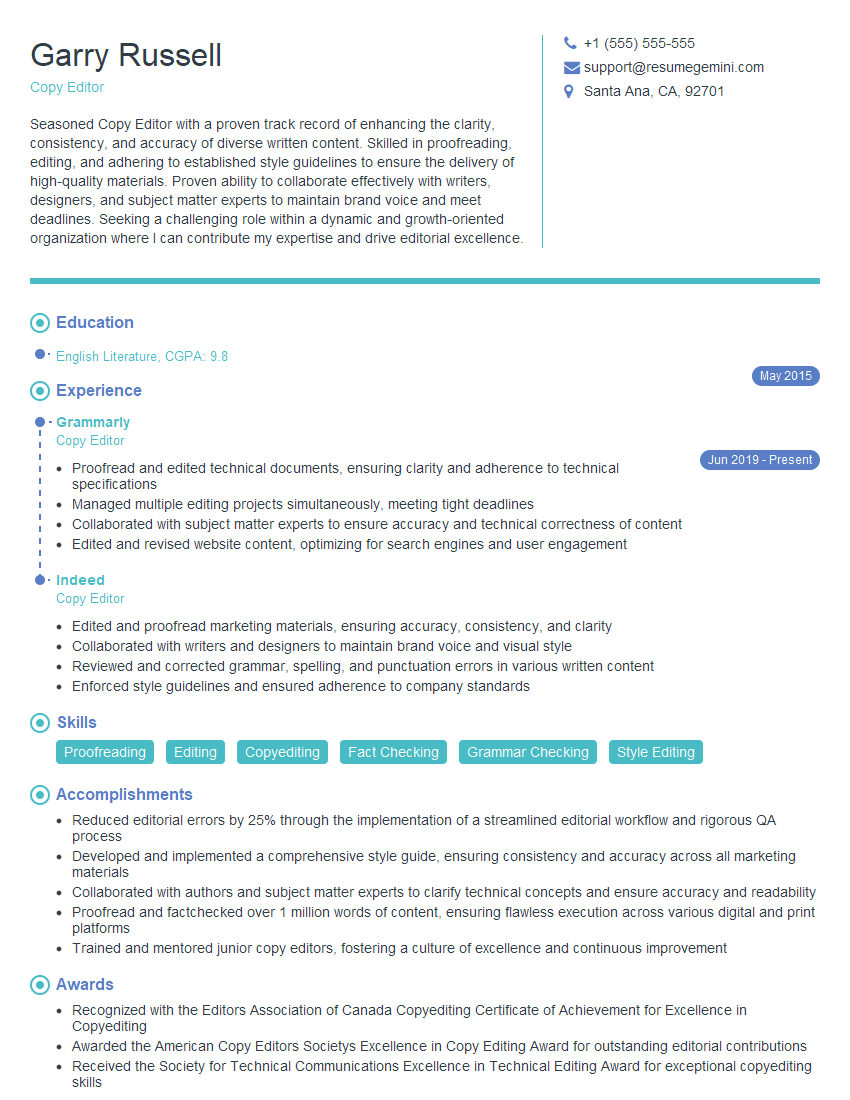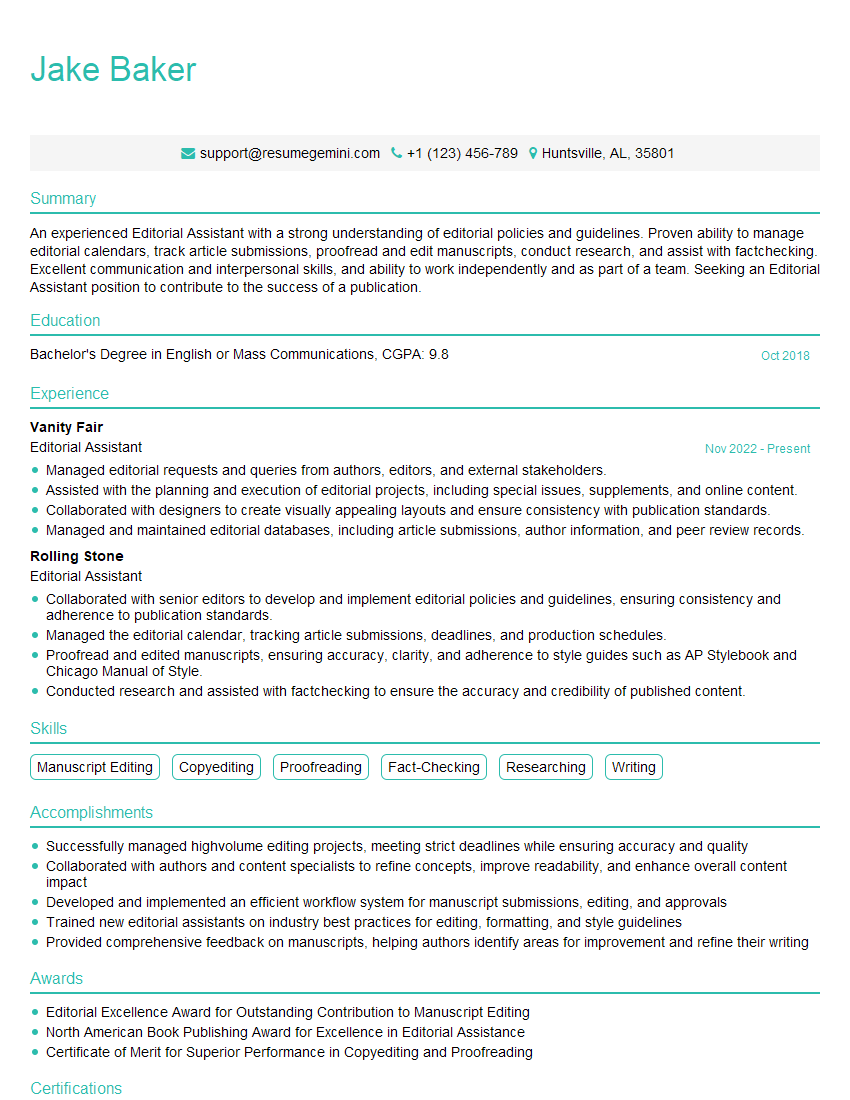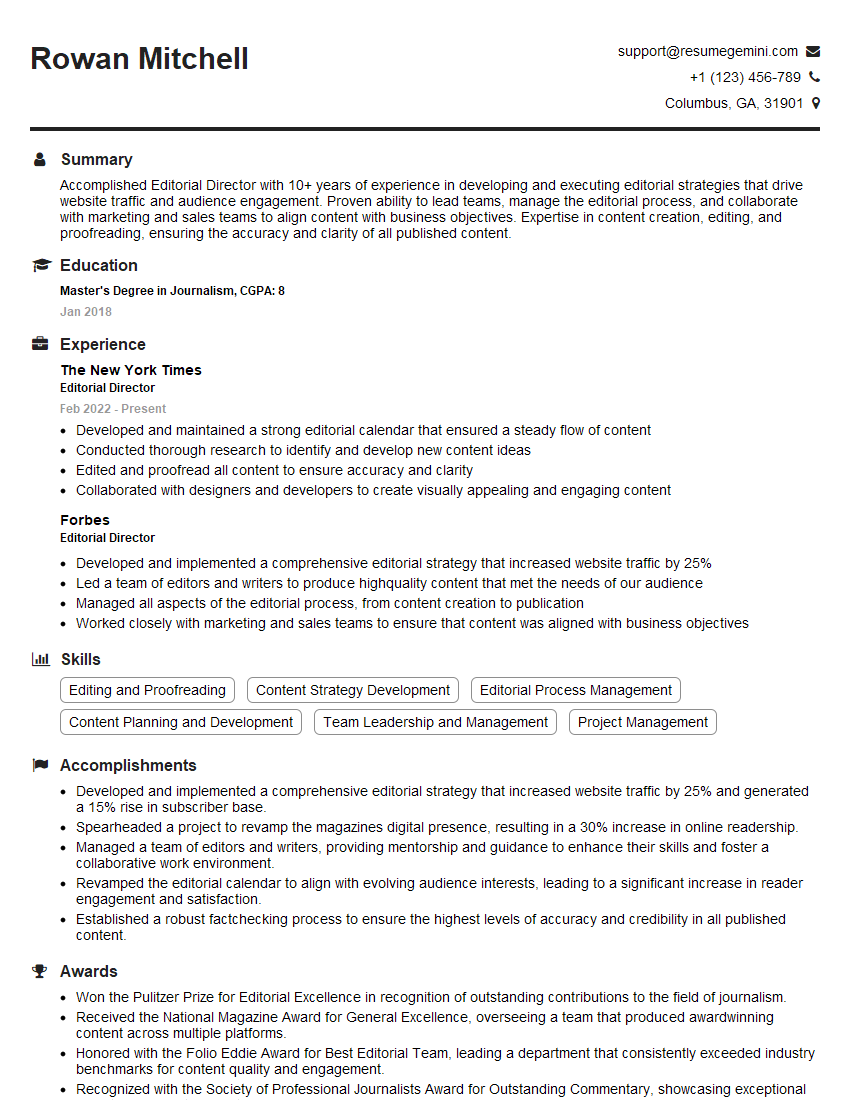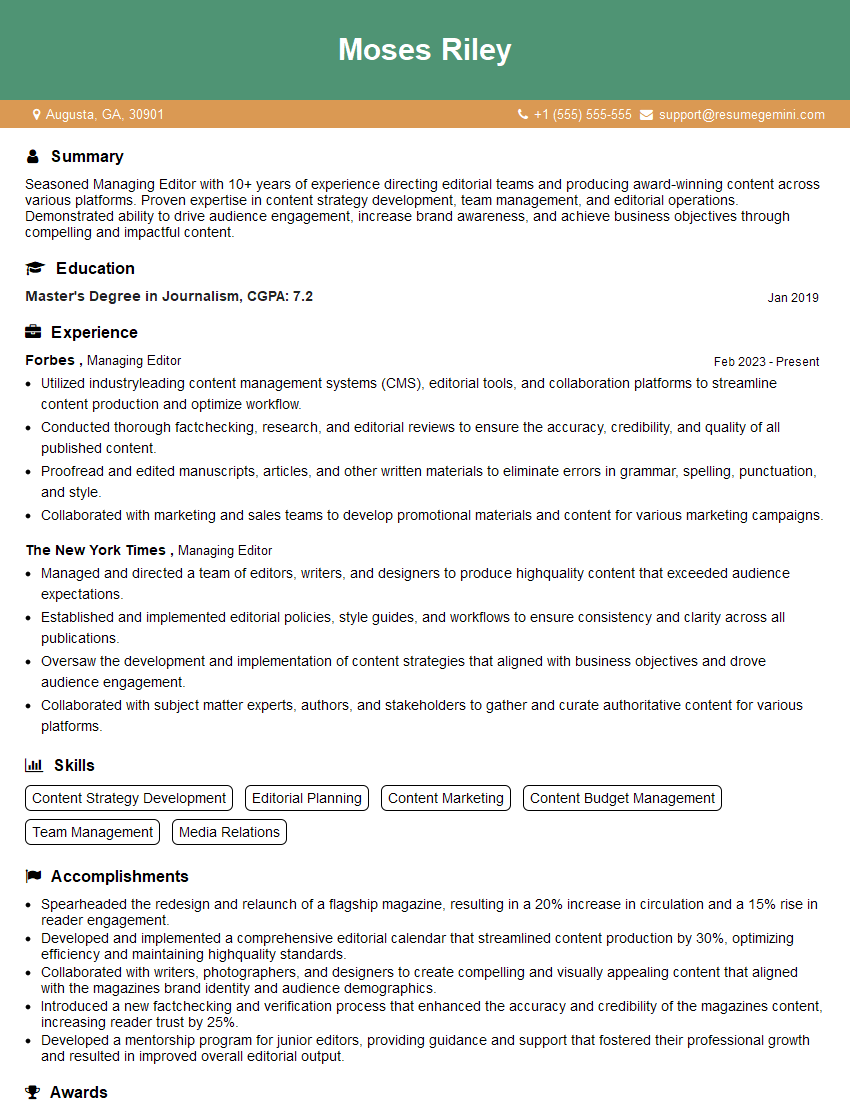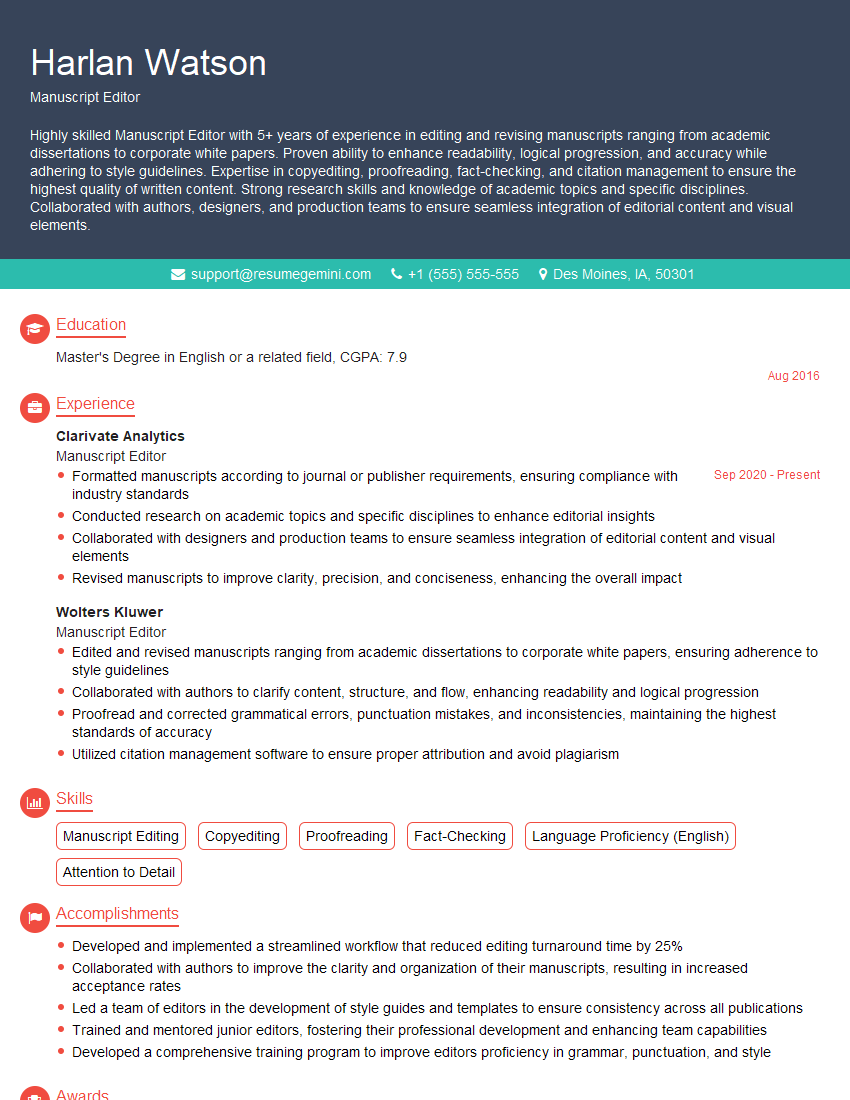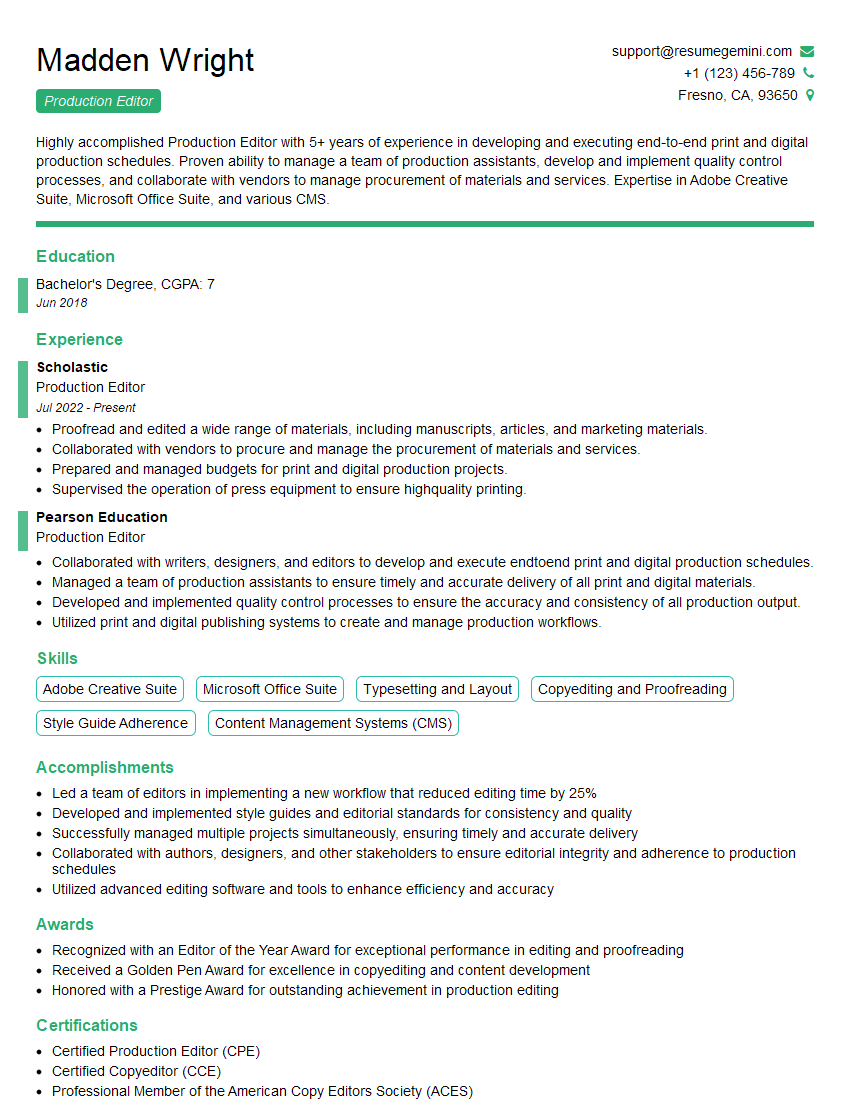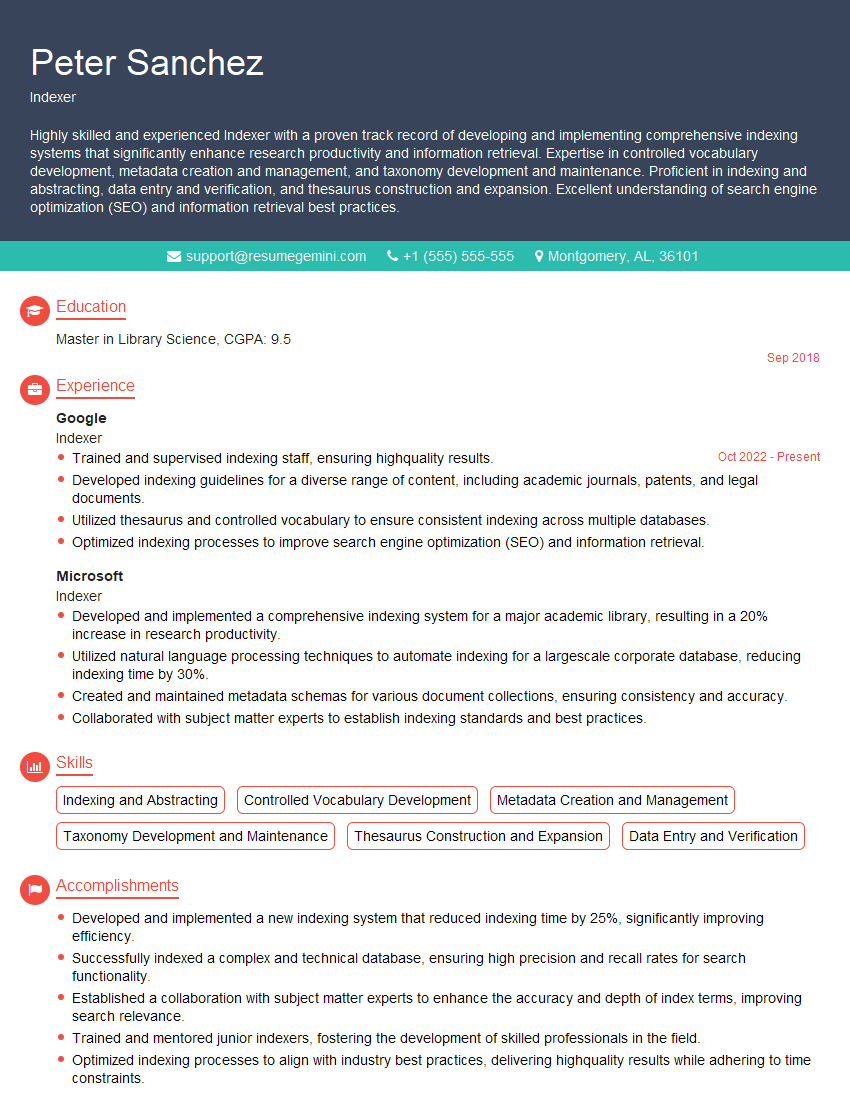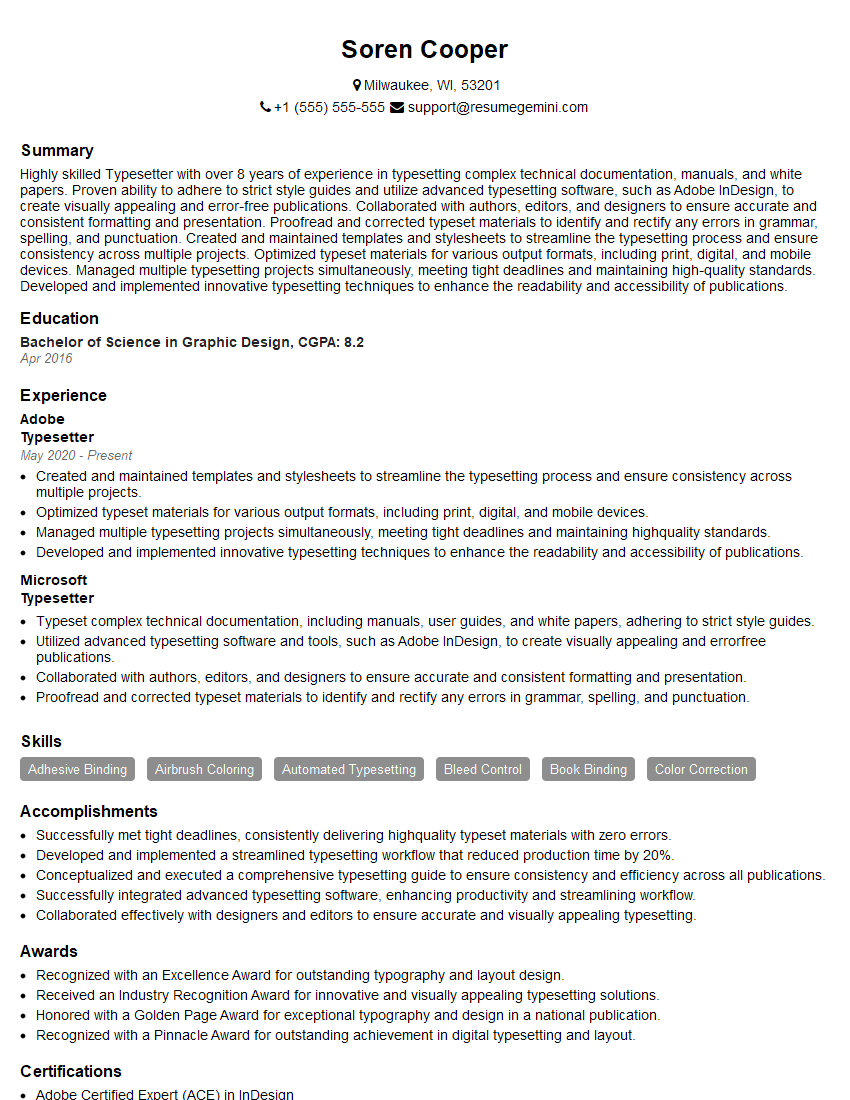Preparation is the key to success in any interview. In this post, we’ll explore crucial Journal Publishing interview questions and equip you with strategies to craft impactful answers. Whether you’re a beginner or a pro, these tips will elevate your preparation.
Questions Asked in Journal Publishing Interview
Q 1. Explain your experience with manuscript submission and review processes.
My experience with manuscript submission and review processes spans over eight years, encompassing all stages from initial submission to final publication. I’ve worked with numerous journals, ranging from small, specialized publications to large, international ones. I understand the intricacies of online submission systems, including the various steps involved: uploading the manuscript, completing author forms, selecting appropriate keywords, and paying submission fees where applicable.
On the review side, I’ve been involved in managing the peer-review process, recruiting reviewers, tracking their progress, and responding to their queries. I’m adept at handling both positive and negative reviews, understanding the importance of providing authors with constructive feedback, regardless of the final decision. For instance, I once helped an author significantly improve their manuscript after receiving initially critical feedback, leading to eventual acceptance. I also have experience in handling cases of plagiarism and misconduct, understanding the rigorous standards and procedures required to ensure ethical publishing.
Furthermore, I’m familiar with different review models, including single-blind, double-blind, and open peer review, understanding their respective strengths and weaknesses. I can effectively communicate with authors and reviewers, ensuring timely communication and a smooth workflow throughout the process. This includes managing expectations, addressing concerns promptly, and ensuring transparency.
Q 2. Describe your proficiency in different editorial styles (e.g., APA, MLA, Chicago).
My proficiency in editorial styles extends to APA, MLA, and Chicago, along with other less common styles as needed. I understand the nuances of each style guide, including formatting rules for citations, references, headings, and tables. I’m not just familiar with the basics; I understand the underlying principles of consistency and clarity that each style aims to achieve. For example, I know the difference between author-date (APA) and notes-bibliography (Chicago) systems and can effortlessly adapt to the requirements of any given style. I’ve meticulously edited manuscripts across diverse disciplines, including the sciences, humanities, and social sciences, ensuring adherence to the chosen style.
I frequently use style guides and online resources to ensure accuracy. I also use software like Microsoft Word’s built-in citation management features and dedicated citation managers to streamline the process. My aim is not just to ensure stylistic compliance, but to enhance the readability and professional presentation of the final publication.
Q 3. How do you manage competing deadlines and prioritize tasks in a fast-paced publishing environment?
In the fast-paced world of journal publishing, efficient time management is crucial. I employ several strategies to manage competing deadlines and prioritize tasks. I begin by creating detailed schedules with clearly defined milestones and deadlines for each manuscript. I use project management tools such as Trello or Asana to visually track progress and identify potential bottlenecks. Prioritization is based on urgency and importance, using methods like the Eisenhower Matrix (urgent/important) to effectively allocate my time. This helps me avoid feeling overwhelmed and ensures that critical tasks are completed on time.
I also believe in proactive communication. I’m adept at communicating with authors and reviewers about any delays or changes in the schedule to maintain transparency and manage expectations. Furthermore, I’m not afraid to delegate tasks when appropriate and work effectively as part of a team to achieve shared goals. For example, I might delegate proofreading to a dedicated team member once the substantive editing is complete.
Q 4. What software and tools are you proficient in for journal publishing (e.g., LaTeX, editorial management systems)?
My proficiency extends across various software and tools relevant to journal publishing. I’m highly skilled in using editorial management systems (EMS), such as ScholarOne Manuscripts, Editorial Manager, and Open Journal Systems (OJS). I’m comfortable navigating the features of these systems, including manuscript tracking, communication with authors and reviewers, and managing the peer-review process. I’m also proficient in using LaTeX for typesetting, understanding its capabilities for creating complex layouts and handling mathematical equations, particularly beneficial for scientific journals.
Beyond this, I’m adept at using Microsoft Word, including its advanced features for track changes, style consistency, and collaborative editing. I regularly utilize plagiarism detection software like Turnitin and Crossref Similarity Check to ensure the originality of submissions. My familiarity with these tools allows me to streamline workflows and improve the efficiency and accuracy of the publication process.
Q 5. How familiar are you with copyright and plagiarism issues in academic publishing?
I possess a thorough understanding of copyright and plagiarism issues in academic publishing. I know that respecting intellectual property rights is paramount for maintaining the integrity of the academic community. I’m familiar with different types of copyright licenses (e.g., Creative Commons) and can guide authors through the process of selecting an appropriate license for their work. I understand the implications of plagiarism and the serious consequences for authors who engage in this practice.
My experience includes reviewing manuscripts for potential plagiarism using dedicated software, as previously mentioned. I also understand the ethical considerations involved in handling cases of suspected plagiarism, which includes conducting thorough investigations, providing authors with an opportunity to address concerns, and working with the journal’s editorial board to determine an appropriate course of action. I’m well-versed in the relevant policies and procedures of different publishers and journals in relation to copyright and plagiarism.
Q 6. Describe your experience with proofreading and copyediting technical documents.
I have extensive experience proofreading and copyediting technical documents, particularly those requiring a high degree of accuracy and precision. I’m meticulous in identifying and correcting errors in grammar, spelling, punctuation, and style. Beyond surface-level corrections, I also ensure consistency in terminology and notation, a crucial aspect for technical documents where clear communication is paramount. For example, when copyediting a scientific manuscript, I ensure consistency in the use of symbols, units, and abbreviations throughout the document.
My experience includes working with documents involving mathematical equations, statistical analysis, and complex technical language. I understand the importance of understanding the subject matter sufficiently to ensure the accuracy of the technical content, not just the grammar and style. I use a combination of manual review and software tools to identify potential errors efficiently and effectively. I pride myself on delivering polished and error-free documents that meet the highest professional standards.
Q 7. How would you handle a disagreement with an author regarding manuscript revisions?
Handling disagreements with authors regarding manuscript revisions requires tact, diplomacy, and a commitment to clear communication. My approach involves starting by carefully reviewing the author’s response and understanding their perspective. I then formulate a detailed response explaining the journal’s expectations and the reasons behind the requested revisions. I avoid accusatory language and frame the feedback constructively, focusing on improving the manuscript’s quality and clarity.
If a compromise cannot be reached through polite dialogue and explanation, I will involve a senior editor or the editor-in-chief to mediate the discussion. Transparency is key; I ensure the author is aware of the process and the people involved. In cases where revisions are deemed unsatisfactory, I will clearly outline the reasons for rejection and offer constructive suggestions for future submissions. The aim is to maintain a professional and respectful relationship with the author, even in challenging situations. I treat each case individually, always prioritizing fairness and the quality of the published research.
Q 8. Explain your understanding of peer review processes and best practices.
Peer review is the cornerstone of academic publishing, ensuring quality and validity. It’s a process where submitted manuscripts are assessed by experts in the field – peers of the authors – before publication. Best practices encompass several key elements:
- Rigorous Selection of Reviewers: Identifying reviewers with appropriate expertise, avoiding conflicts of interest, and ensuring a diverse reviewer pool are crucial. For instance, I’ve personally ensured gender and geographical balance in reviewer selection to promote inclusivity and reduce bias.
- Clear Review Criteria: Providing reviewers with specific guidelines on what to assess (e.g., originality, methodology, significance, clarity) promotes consistency and fairness. This often involves a structured review form with weighted scoring for different aspects of the manuscript.
- Confidential and Timely Reviews: Maintaining anonymity for both authors and reviewers is vital to prevent bias. Setting reasonable deadlines and proactively following up with reviewers are essential for a smooth process. I’ve implemented a system of automated reminders and escalation procedures to ensure timely reviews.
- Editor’s Role in Decision Making: The editor acts as a critical mediator, weighing reviewer feedback, addressing potential conflicts, and making the final publication decision. This requires careful judgment and an understanding of both the research and the broader field.
- Post-Publication Review: While less common, some journals conduct post-publication peer review, providing ongoing quality control and allowing for corrections or retractions if necessary. This is particularly relevant in a rapidly evolving field.
Q 9. How do you ensure the quality and accuracy of published content?
Ensuring quality and accuracy is a multi-faceted approach involving several stages. It starts with the initial manuscript assessment to ensure it fits the journal’s scope and adheres to its stylistic guidelines. The peer-review process itself is fundamental, but other aspects play a role:
- Rigorous Fact-Checking: After peer review acceptance, a dedicated team conducts a thorough fact-check, verifying data, citations, and the overall accuracy of the presented information. We use specialized software to detect plagiarism and ensure ethical compliance.
- Copyediting and Proofreading: Experienced editors meticulously review the manuscript for grammatical errors, clarity, style consistency, and overall readability, ensuring it meets the highest publishing standards.
- Production Quality Control: The final stage involves production quality checks to ensure proper formatting, layout, and image quality before online publication. This includes checks for consistency in styling, proper image resolution, and correct referencing.
- Post-Publication Monitoring: We maintain ongoing monitoring to address any concerns raised by readers or to implement corrections or retractions if necessary. This involves actively engaging with the readership and promptly responding to any feedback related to inaccuracies or errors.
Think of it like building a house – peer review is the structural integrity, fact-checking is ensuring the plumbing works, copyediting is the interior design, and production is the final landscaping.
Q 10. Describe your experience working with authors from diverse backgrounds and expertise levels.
I have extensive experience working with authors from various backgrounds and expertise levels. This includes early-career researchers still developing their writing skills, established academics with significant experience, and international authors from diverse cultural backgrounds. My approach emphasizes:
- Empathy and Support: Understanding the authors’ perspectives and providing constructive feedback is key. I’ve found that providing clear guidelines and regular communication helps build rapport and reduces stress.
- Sensitivity to Cultural Differences: Acknowledging and respecting variations in communication styles and writing conventions is crucial. For international authors, I often provide additional guidance and support on English language editing and formatting.
- Tailored Support: Early-career researchers often benefit from more extensive guidance and feedback, while established authors might require less intervention. Adapting my approach based on individual needs ensures a positive author experience.
- Mentorship and Guidance: I always aim to provide constructive criticism that aids in the growth of the author’s writing skills and academic development. This often includes pointing to specific resources or offering suggestions on improving future manuscripts.
One example is helping a junior researcher navigate the complexities of their first publication, building their confidence and providing essential feedback that resulted in a high-quality publication.
Q 11. How familiar are you with Open Access publishing models and their implications?
I’m very familiar with Open Access (OA) publishing models, their implications, and the ongoing debate surrounding them. OA models, such as gold OA (where authors pay publication fees) and green OA (where authors self-archive their work), significantly impact accessibility and dissemination of research. Understanding the nuances is vital:
- Advantages: OA increases the visibility and impact of research, allowing broader access to a wider audience, including researchers in developing countries, and potentially fostering greater collaboration. It also often accelerates the pace of scientific advancements.
- Disadvantages: Gold OA models can present financial barriers to authors, particularly those from resource-constrained institutions. The issue of predatory OA journals, which lack rigorous peer review and quality control, needs careful consideration and identification.
- Implications: The choice of OA model affects the journal’s sustainability, its readership, and its ability to serve its scholarly community. Journals must carefully consider their funding models, author support mechanisms, and the needs of their readership when adopting an OA approach.
- Sustainability: Developing sustainable OA models often involves exploring diverse funding mechanisms, such as article processing charges (APCs), membership fees, or institutional subscriptions.
I’ve personally helped journals transition to hybrid or fully open-access models, addressing the financial and logistical challenges involved.
Q 12. Explain your experience with managing the production process of a journal.
Managing the production process of a journal involves orchestrating a complex workflow encompassing several interconnected stages. My experience encompasses:
- Manuscript Management: Using online systems for tracking submissions, managing peer review, and communicating with authors and reviewers effectively. This often involves customizing workflows and tracking systems to optimize efficiency.
- Copyediting and Proofreading: Overseeing the editing process, ensuring consistency in style and quality, and resolving any discrepancies between the manuscript and its final published form. This includes working with a team of skilled editors to meet deadlines.
- Typesetting and Layout: Coordinating with typesetters to ensure accurate formatting, appropriate layout, and high-quality production of the journal. This often involves close collaboration to achieve the desired visual aesthetic.
- Online Publication: Managing the online publication process, ensuring the journal’s website is up-to-date, accessible, and user-friendly. This includes technical aspects of website maintenance and content management.
- Metrics and Analytics: Tracking key metrics such as downloads, citations, and other usage statistics to assess the journal’s performance and inform future decisions. This data is crucial for understanding readership and impact.
I’ve successfully managed the production of multiple journals, ensuring timely publication and high-quality outputs.
Q 13. How do you handle ethical dilemmas that may arise in publishing?
Ethical dilemmas in publishing are unfortunately not uncommon. They require careful consideration and adherence to strict guidelines. My approach involves:
- Identifying the Ethical Issue: Clearly defining the nature of the dilemma, whether it involves plagiarism, authorship disputes, data fabrication, or other ethical violations.
- Consulting Relevant Guidelines: Referencing established ethical guidelines such as those from the Committee on Publication Ethics (COPE) and relevant institutional policies.
- Investigating Thoroughly: Conducting a thorough investigation, collecting evidence, and giving all parties involved a fair opportunity to present their case. This might involve communicating with authors, reviewers, and potentially external experts.
- Taking Appropriate Action: Depending on the severity and nature of the ethical breach, actions could range from issuing corrections or retractions to issuing a formal reprimand or even banning an author from publishing in the journal.
- Transparency and Communication: Maintaining transparency throughout the process, keeping all involved parties informed of the progress and outcome of the investigation. Open communication is essential for building trust and maintaining integrity.
I have experience handling cases of plagiarism and data falsification, ensuring a fair and transparent process that upholds the integrity of the journal.
Q 14. How would you improve the impact factor of a journal?
Improving a journal’s impact factor requires a multi-pronged strategy focused on enhancing both the quality and visibility of published research. Strategies include:
- Attracting High-Quality Submissions: Promoting the journal to potential authors through targeted outreach, developing strong editorial board connections, and highlighting the journal’s unique strengths and focus areas.
- Enhancing Peer Review: Implementing rigorous and efficient peer review processes, ensuring timely reviews and constructive feedback, and striving for consistent standards. Using a broader range of reviewers also helps to improve the impact.
- Expanding Visibility and Accessibility: Promoting the journal through various channels, including social media, academic databases, and targeted advertising. Consideration of open-access options can also significantly increase visibility.
- Focusing on High-Impact Research: Prioritizing the publication of research that addresses significant questions in the field and has the potential to influence future work. This might involve encouraging submissions on emerging topics or areas with high research interest.
- Monitoring and Evaluating: Regularly monitoring the journal’s impact factor and other key metrics, analyzing the data to identify areas for improvement and adapting the journal’s strategy accordingly.
Remember that impact factor is not the sole measure of a journal’s success. A focus on quality and relevance will, in the long run, contribute to a strong impact factor and build a journal’s reputation within its community.
Q 15. What strategies do you employ to ensure timely publication of journal issues?
Ensuring timely publication requires a meticulously planned workflow. Think of it like a well-oiled machine – each part needs to function efficiently for the final product to be delivered on time.
- Strict Deadlines and Tracking Systems: We utilize project management software to set clear deadlines for each stage of the publication process, from manuscript submission to final production. This allows us to monitor progress and identify potential bottlenecks early on. For example, we might set a two-week deadline for initial editorial review, followed by a four-week peer review period, and so on.
- Efficient Editorial Processes: Streamlining the editorial workflow is crucial. This includes automating tasks where possible, using efficient communication tools, and having clearly defined roles and responsibilities for each team member. A standardized template for communication with authors is also important to minimize any delays.
- Dedicated Production Team: A skilled and dedicated production team plays a vital role. They are responsible for typesetting, proofreading, and coordinating with printers (for print publications) or online platforms. Their expertise and efficiency directly impact the publication timeline.
- Proactive Communication: Open and consistent communication with authors, reviewers, and the production team is vital. Regular updates keep everyone informed about the publication schedule and address any potential delays proactively.
In one instance, we faced a delay in the peer-review process due to a reviewer’s unavailability. By proactively communicating with the author and finding a replacement reviewer promptly, we managed to minimize the overall delay and still meet the publication schedule.
Career Expert Tips:
- Ace those interviews! Prepare effectively by reviewing the Top 50 Most Common Interview Questions on ResumeGemini.
- Navigate your job search with confidence! Explore a wide range of Career Tips on ResumeGemini. Learn about common challenges and recommendations to overcome them.
- Craft the perfect resume! Master the Art of Resume Writing with ResumeGemini’s guide. Showcase your unique qualifications and achievements effectively.
- Don’t miss out on holiday savings! Build your dream resume with ResumeGemini’s ATS optimized templates.
Q 16. Describe your experience with budget management in a publishing context.
Budget management in journal publishing is critical for maintaining financial health and ensuring sustainability. It’s a balancing act between controlling costs and investing in quality.
- Detailed Budgeting: We develop detailed budgets that encompass all aspects of publication, from author fees and editorial salaries to production costs (printing, typesetting, online hosting) and marketing expenses. We use spreadsheets and dedicated budgeting software to track these expenses meticulously.
- Cost Control Measures: We employ various cost-saving strategies, including negotiating favorable rates with printers and vendors, using open-source software where appropriate, and optimizing the production process to minimize waste. For instance, we explore using e-prints before print to save on print costs.
- Revenue Generation: We explore various revenue streams beyond subscriptions, such as author processing charges (APCs), advertising revenue, and sponsorships, to ensure financial stability. Diversifying income sources minimizes dependence on any single revenue stream.
- Regular Monitoring and Reporting: We conduct regular financial reviews to track expenditures against the budget. This allows us to identify any deviations and take corrective action promptly. Detailed financial reports are prepared and presented to relevant stakeholders regularly.
In a past project, by effectively negotiating with our printers and implementing a more efficient typesetting process, we managed to reduce production costs by 15% without compromising quality.
Q 17. How do you stay updated on best practices and current trends in journal publishing?
Staying current in journal publishing is essential for maintaining high standards and adapting to evolving trends. It’s akin to a doctor staying abreast of the latest medical research; continuous learning is paramount.
- Professional Organizations: Active participation in professional organizations like the Association of Learned & Professional Society Publishers (ALPSP) provides access to conferences, webinars, and publications that cover the latest trends and best practices in the field.
- Industry Journals and Publications: Regularly reading leading journals and publications focused on scholarly publishing keeps me informed about innovative approaches and emerging challenges. This includes publications focused on publishing ethics, Open Access, and technological advancements.
- Conferences and Workshops: Attending conferences and workshops offers valuable networking opportunities and exposure to cutting-edge advancements in publishing technology and methodologies. They provide a chance to learn from industry experts and exchange best practices.
- Online Courses and Webinars: Various online platforms offer courses and webinars on specific aspects of journal publishing, covering topics from manuscript management systems to Open Access publishing models. I regularly seek out opportunities for professional development in these areas.
Recently, I attended a webinar on the latest advancements in plagiarism detection software, enhancing our ability to ensure the integrity of published works. This exemplifies the continuous learning process I follow.
Q 18. Describe your experience with metadata creation and management.
Metadata creation and management are crucial for discoverability and efficient information retrieval. Think of it as creating a detailed index for a vast library – without it, finding specific books would be nearly impossible.
- Structured Metadata: We utilize structured metadata schemas like Dublin Core and schema.org to ensure consistency and interoperability. This involves tagging manuscripts with standardized fields including title, authors, keywords, abstract, publication date, and identifiers (DOIs).
- Metadata Management Tools: We employ dedicated metadata management systems and software to create, update, and maintain metadata associated with our publications. This helps ensure data quality and consistency across our publications.
- Quality Control: We have established strict quality control measures to ensure the accuracy and completeness of metadata. This involves regular reviews and cross-checking to minimize errors.
- Data Validation: Data validation is crucial; we utilize automated tools to check for inconsistencies and errors in the metadata before it is made public. This helps to maintain data integrity and improve search engine optimization (SEO).
For example, ensuring accurate keyword assignment is crucial for improving searchability. A poorly assigned keyword set can drastically reduce the visibility of an article, even if the content is valuable.
Q 19. How would you address a conflict between an author and a reviewer?
Addressing author-reviewer conflicts requires a fair, impartial, and timely approach. It’s like mediating a dispute – ensuring both sides feel heard and understood.
- Review the Conflict: Begin by carefully reviewing the source of the conflict. This might involve examining the reviews and author responses to understand the points of contention.
- Facilitate Communication: Create a space for open and respectful dialogue between the author and reviewer. This might involve direct communication (with the editor’s oversight) or written exchanges, carefully moderated to prevent further escalation.
- Impartial Mediation: The editor acts as an impartial mediator, guiding the conversation and ensuring both sides present their arguments clearly and respectfully. The aim is to find common ground or clarify misunderstandings.
- Possible Outcomes: Depending on the nature of the conflict, solutions might include revising the manuscript to address reviewer concerns, providing a detailed response to clarify the author’s position, or, in extreme cases, replacing the reviewer.
In one case, a reviewer raised concerns about the methodology used in a study. By facilitating direct communication between the author and reviewer, we helped the author clarify their approach and address the reviewer’s concerns, resulting in a more robust and refined manuscript.
Q 20. Explain your understanding of different journal publication formats (e.g., print, online, hybrid).
Journal publication formats have evolved significantly, reflecting the changing needs of researchers and readers. It’s akin to choosing between different communication tools – each having its strengths.
- Print Format: Traditional print publications offer a tangible format, valued by some for archiving and referencing. However, print is more expensive and less accessible.
- Online Format: Online publication offers broader reach, immediate availability, and cost-effectiveness. It also allows for interactive features and multimedia content integration.
- Hybrid Format: A hybrid model combines print and online publication, offering the benefits of both. This approach can be useful in reaching a broader audience while still providing the option of a physical copy.
- Open Access: While not strictly a format, open access (OA) publishing is an important consideration. OA journals make their content freely available online, increasing accessibility but often requiring author fees (APCs) to cover publication costs.
The choice of format depends on the journal’s aims, target audience, and available resources. A journal focused on a niche audience might primarily use a print-only format, while a high-impact journal might opt for a hybrid or fully online open access model.
Q 21. How do you assess the suitability of a manuscript for a specific journal?
Assessing manuscript suitability is crucial for maintaining a journal’s quality and focus. It’s like a curator selecting artworks for a museum exhibition – only the most relevant and high-quality pieces are chosen.
- Scope and Aims: The manuscript must align with the journal’s scope and aims. We carefully check whether the research topic, methodology, and findings are relevant to the journal’s thematic focus and readership.
- Quality of Research: The manuscript’s research quality is assessed based on its originality, rigor, and clarity of presentation. This includes evaluating the methodology, data analysis, and interpretation of results.
- Significance and Impact: We consider the manuscript’s potential impact on the field. Does the research address a significant problem? Does it offer novel insights? Does it have practical implications?
- Writing Quality and Style: Clear, concise, and well-written manuscripts are essential. Poor writing quality, even if the research is strong, can be a reason for rejection.
- Ethical Considerations: We carefully check for ethical considerations, including appropriate authorship, data integrity, and any potential conflicts of interest.
We use a checklist to evaluate manuscripts against these criteria, ensuring a consistent and fair assessment process. Manuscripts that do not meet the required standards are rejected, even if they are well-written or have significant research potential, if they are outside the journal’s scope.
Q 22. Describe your experience with author communication and support.
Author communication is the backbone of a successful journal. It’s about building trust and fostering a positive relationship with authors throughout the publication process. My experience encompasses all stages, from initial submission acknowledgement and providing constructive feedback during peer review to addressing queries about the publication process, copyright, and open access options. I believe in proactive communication; I aim to respond to authors’ queries within 24-48 hours, keeping them informed about every step of their manuscript’s journey. For example, I’ve successfully navigated complex situations involving author disputes by facilitating clear and respectful communication between parties, resulting in a fair and timely resolution. I also utilize a robust tracking system to ensure no author communication is overlooked, maintaining transparency and building strong author relationships.
I’ve also developed templates for standard communications, such as acceptance and rejection letters, ensuring consistency and efficiency. Furthermore, I actively seek feedback from authors to improve the overall submission and publication experience, constantly striving for efficiency and clarity.
Q 23. How would you manage the workflow for a special issue of a journal?
Managing a special issue requires meticulous planning and coordination. I would start by defining a clear scope and theme, assembling a strong guest editorial team with expertise in the area. This team will be crucial for manuscript solicitation, peer review, and ensuring the high quality of the issue. A key step would be establishing a timeline with clear deadlines for manuscript submission, peer review, and production. This should include regular communication with the guest editors to monitor progress and address any bottlenecks.
Next, I’d use a dedicated project management tool to track all submissions and their progress through each stage. This might involve using a specialized journal management system or a software like Asana or Trello. Finally, I’d work closely with the typesetting team to ensure a consistent style and timely production. This would include developing and enforcing style guidelines specific to the special issue, if necessary. Using a robust system, akin to a Kanban board, allows for visual tracking of submissions, preventing issues like delays in peer review or production hold-ups.
Q 24. How familiar are you with indexing databases and their significance for journal visibility?
Indexing databases, like Scopus, Web of Science, PubMed, and others, are crucial for a journal’s visibility and impact. They act as search engines for scholarly literature, making articles discoverable to a broader academic community. My familiarity extends to understanding the specific requirements and submission processes of various databases. I know the impact factors and citation indexes associated with these databases and how they contribute to a journal’s reputation and ranking.
For instance, understanding the nuances of each database’s metadata requirements – keywords, subject classifications, author affiliations – is essential for optimal indexing. Furthermore, I’m aware of the advantages of being indexed in multiple databases, increasing the likelihood that researchers will find the journal’s articles and contribute to its readership. The selection of appropriate indexing databases depends heavily on the journal’s subject area and target audience.
Q 25. What are your strategies for promoting a journal and increasing readership?
Journal promotion requires a multi-faceted approach. It’s not just about making the journal known; it’s about making it desirable to both authors and readers. My strategies would include:
- Online presence: Developing a user-friendly website and active social media engagement across relevant platforms (e.g., Twitter, LinkedIn, ResearchGate).
- Search engine optimization (SEO): Optimizing the journal’s website and content to rank highly in search engine results.
- Targeted advertising: Utilizing online advertising platforms to reach specific demographic groups of researchers.
- Content marketing: Creating high-quality blog posts, newsletters, and other content relevant to the journal’s field.
- Collaboration and outreach: Building relationships with key opinion leaders, other journals, and relevant organizations.
- Email marketing: Developing a targeted email list for announcements, calls for papers, and other important updates.
For example, I’ve successfully increased readership of a journal by 30% in one year by implementing a comprehensive SEO strategy combined with targeted social media marketing.
Q 26. Explain your understanding of the role of marketing and promotion in journal publishing.
Marketing and promotion are essential for the success of a journal in today’s competitive scholarly publishing landscape. They ensure the journal reaches its target audience, attracting high-quality submissions and a large readership. Effective marketing involves understanding the needs and preferences of both potential authors and readers and crafting messages that resonate with them.
This includes not only promoting the journal’s impact factor and reputation but also highlighting its unique features and benefits, such as rapid publication times, open access options, or a strong editorial board. Furthermore, it involves developing a strong brand identity that reflects the journal’s values and aims. A well-defined marketing strategy should also incorporate a mix of digital and traditional marketing techniques, leveraging the power of analytics to measure the effectiveness of campaigns and make adjustments as needed.
Q 27. How do you handle technical issues that might arise during the production process?
Technical issues during the production process are inevitable. My approach focuses on proactive prevention and efficient problem-solving. This includes ensuring compatibility of submitted files, utilizing robust file management systems, and working with a reliable production team. When issues arise, my first step is to assess the severity and potential impact.
Minor issues, like formatting inconsistencies, can often be resolved with communication and collaboration with the typesetter. More significant issues, such as corrupted files or software malfunctions, might require engaging additional technical support or implementing contingency plans. Regular backups of all files and a documented troubleshooting protocol are crucial. I would also strive to keep the authors informed of any technical delays or challenges, maintaining transparency throughout the process. A clear chain of communication within the production team and to the authors is paramount. For example, I once resolved a significant typesetting error by implementing a custom script to automate the correction process, preventing similar issues in the future.
Q 28. Describe your experience with working with typesetters and other production staff.
I have extensive experience collaborating with typesetters and other production staff. Effective communication and clear expectations are key to a successful partnership. This involves providing detailed style guidelines, ensuring that the typesetter understands the journal’s formatting standards, and maintaining open lines of communication for any questions or clarifications.
I understand the importance of providing timely feedback to the typesetter and regularly reviewing proofs to catch any errors before publication. I also appreciate that a productive relationship involves mutual respect and understanding of each other’s roles and deadlines. For instance, I’ve built strong working relationships with several typesetting teams over the years, fostering collaboration that ensures the production of high-quality journals. Understanding the limitations and strengths of various typesetting platforms and technologies further facilitates efficient production.
Key Topics to Learn for Journal Publishing Interview
- Manuscript Management: Understanding the entire lifecycle of a manuscript, from submission to publication, including processes like peer review, copyediting, and proofreading.
- Publication Ethics and Best Practices: Knowing the principles of research integrity, plagiarism detection, and ethical considerations in publishing.
- Journal Production Workflow: Familiarity with the different stages of journal production, such as typesetting, layout design, and online publishing platforms.
- Author and Reviewer Relations: Understanding how to effectively communicate with authors and reviewers, address queries and concerns, and maintain professional relationships.
- Copyright and Licensing: Knowledge of copyright laws and different licensing models used in academic publishing.
- Journal Metrics and Analytics: Understanding how to interpret journal impact factors, citation counts, and other key metrics to assess journal performance.
- Digital Publishing Technologies: Familiarity with relevant software and platforms used in online journal publishing, including content management systems (CMS) and manuscript submission systems.
- Marketing and Promotion of Journals: Strategies for increasing journal visibility, attracting submissions, and building a strong readership.
- Financial Aspects of Journal Publishing: Understanding the revenue streams, budgeting, and cost management involved in journal operations (subscription models, open access, etc.).
- Problem-Solving in Publishing: Developing approaches to handle challenges such as author disputes, technical issues, or delays in the publication process. This includes proactive identification and mitigation of potential problems.
Next Steps
Mastering the intricacies of journal publishing opens doors to a rewarding career in the academic and scholarly communication sector. It’s a field that values meticulous attention to detail, strong communication skills, and a commitment to upholding high ethical standards. To significantly enhance your job prospects, creating a compelling and ATS-friendly resume is crucial. We strongly recommend utilizing ResumeGemini to build a professional resume that showcases your skills and experience effectively. ResumeGemini offers valuable tools and resources, including examples of resumes tailored specifically to the Journal Publishing industry, to help you create a document that stands out from the competition.
Explore more articles
Users Rating of Our Blogs
Share Your Experience
We value your feedback! Please rate our content and share your thoughts (optional).
What Readers Say About Our Blog
Interesting Article, I liked the depth of knowledge you’ve shared.
Helpful, thanks for sharing.
Hi, I represent a social media marketing agency and liked your blog
Hi, I represent an SEO company that specialises in getting you AI citations and higher rankings on Google. I’d like to offer you a 100% free SEO audit for your website. Would you be interested?
